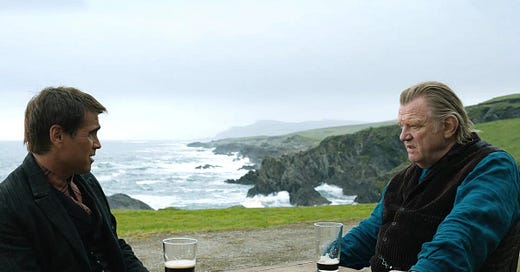"The Banshees of Inisherin."
A movie bigger than its biggest metaphor has ample amounts of ambiguous wonder.
This post contains spoilers for the movie. If you haven’t watched it (on HBO Max), come back when you have.
Periodically in “The Banshees of Inisherin,” characters on the fictional and remote island hear the sounds of explosions in the distance. It’s 1923 and that’s the Irish Civil War on the mainland, but the island residents are removed and barely pay the explosions any mind. But of course, as the film nears its conclusion, it’s hard not to think, correctly, that writer and director Martin McDonagh has told a wildly odd, compelling, heartfelt and sad story about two men on Inisherin who are a metaphor for what that war did to Irish people.
Friends, families, men who had already fought together for Ireland’s independence, all broke apart in anger, confusion — a spiral of division.
“The Banshees of Inisherin” is smart, tidy and wonderfully executed, of course, but also on the surface quite simple. The island is very isolated. Everyone knows everyone. Two very good friends, Colm (Brendan Gleeson) and Padraic (Colin Farrell), have been meeting seemingly every day around 2 p.m. to head to the pub, the social hub of the island, to drink and talk. And be friends. That’s what they do. Until they don’t.
The premise of “The Banshees of Inisherin” is basically that Colm tells Padraic that he doesn’t want to be see him anymore. Doesn’t want to be friends. It’s straight out of the blue and understandably stuns Padraic, the far less worldly and interesting of the two. It makes no sense. Padraic’s sister, Siobhan (Kerry Condon), with whom Padraic lives, along with a horde of livestock in the home of their parents (who have passed), finally just says the obvious — maybe he doesn’t like you anymore.
That, also and understandably, makes no sense to Padraic. Until Colm tells him the same thing. And Colm adds, for reasoning purposes, the Padraic is kind of boring and simple and because Colm is getting older, he wants to do something with his life — specifically write and perform music on his fiddle. Padraic, who tends cows, doesn’t understand how he personally is interfering with that.
Again, it’s beautifully simple. As an audience, we know that the island is remote and life is hard. It’s not like you can meet your life partner there — an issue that’s mostly unsaid. Colm has no wife. Padraic has no wife. Siobhan feels an obligation to Padraic and has no partner of her own, though she does long to leave the island and find a life elsewhere. The bullying and abusive town Garda, Peadar Kearney (Gary Lydon), is apparently a widower and abusing his son, the tragic dullard Dominic (Barry Keoghan), who in turn wonders out loud to Siobhan if she might be a fit for him (no, she says).
So having a connection to someone is important, and Colm inexplicably severing his with Padraic sends the latter into confusion. But that’s where the movie goes from bleak to strange, and where the metaphor of best friends and family members being divided by a civil war has to either be stretched too far to include all the goings on or we have to, as we should, understand that “The Banshees of Inisherin” is about a lot more than a fractured country reflected in two friends.
Keep reading with a 7-day free trial
Subscribe to Tim Goodman / Bastard Machine to keep reading this post and get 7 days of free access to the full post archives.







